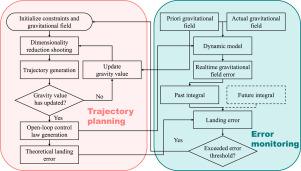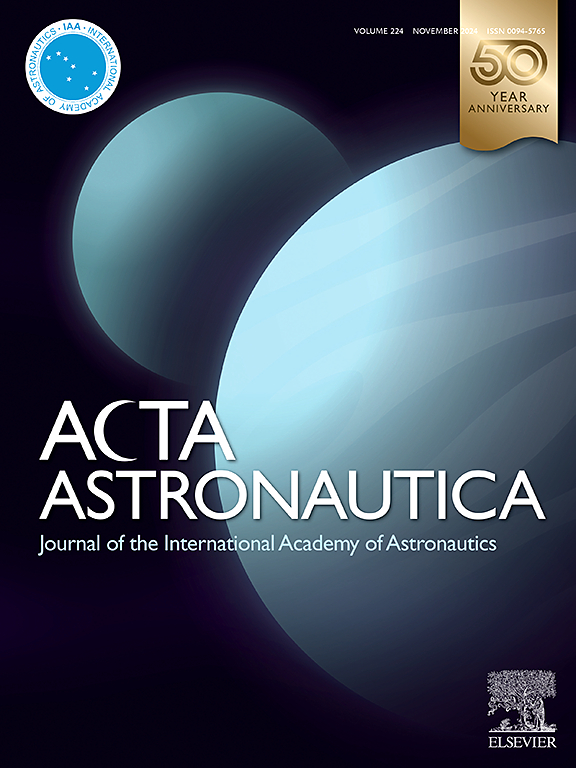半解析近似时间最优小行星着陆降维射击
IF 3.1
2区 物理与天体物理
Q1 ENGINEERING, AEROSPACE
引用次数: 0
摘要
由于重力场的不确定性,在小行星上进行精确定位着陆非常具有挑战性,这凸显了在这种不确定性下对自主着陆算法的迫切需求。一些众所周知的制导算法,如 APDG 和实时凸编程,要么忽略了推力边界约束,要么非常耗时。此外,这些算法在分析模型不确定性传播导致的着陆误差时同样存在困难,使得算法在实际着陆中的可靠性受到质疑。为解决这些难题,我们提出了一种结合模型识别、轨迹分析求解和闭环修正的着陆框架,以实现近乎最优的实时着陆控制。首先,我们简化了着陆场景,重点是减少射击变量的维度,以实现快速轨迹计算。其次,我们推导了误差传播方程,并建立了基于着陆误差预测的轨迹重新规划标准。最后,我们以 "舒梅克 "探测器在厄洛斯 433 上着陆的实际案例验证了我们的方法。通过实时着陆误差估算,我们提出的框架可使航天器在给定误差阈值内实现接近时间最优的着陆。本文章由计算机程序翻译,如有差异,请以英文原文为准。

Semi-analytic approximate time-optimal asteroid landing with dimensionality reduction shooting
Pinpoint landing on asteroid is very challenging due to the uncertainties of the gravitational field, which highlights the urgent need for autonomous landing algorithms under such uncertainties. Some well-known guidance algorithms, such as APDG and real-time convex programming, either ignore thrust boundary constraints or are severely time consuming. In addition, these algorithms have the same difficulty in analyzing landing errors due to model uncertainty propagation, making the reliability of the algorithms in actual landings questionable. To address these challenges, we propose a landing framework that combines model identification, trajectory analytical solution and closed-loop corrections to achieve near-optimal real-time landing control. Firstly, we simplified the landing scenario, focusing on reducing the dimension of shooting variables to enable rapid trajectory calculation. Secondly, we derived error propagation equations and established criteria for trajectory replanning based on landing error prediction. Finally, we validated our approach with practical examples of the Shoemaker probe landing on Eros 433. Through real-time landing error estimation, our proposed framework enables spacecraft to achieve near time-optimal land within a given error threshold.
求助全文
通过发布文献求助,成功后即可免费获取论文全文。
去求助
来源期刊

Acta Astronautica
工程技术-工程:宇航
CiteScore
7.20
自引率
22.90%
发文量
599
审稿时长
53 days
期刊介绍:
Acta Astronautica is sponsored by the International Academy of Astronautics. Content is based on original contributions in all fields of basic, engineering, life and social space sciences and of space technology related to:
The peaceful scientific exploration of space,
Its exploitation for human welfare and progress,
Conception, design, development and operation of space-borne and Earth-based systems,
In addition to regular issues, the journal publishes selected proceedings of the annual International Astronautical Congress (IAC), transactions of the IAA and special issues on topics of current interest, such as microgravity, space station technology, geostationary orbits, and space economics. Other subject areas include satellite technology, space transportation and communications, space energy, power and propulsion, astrodynamics, extraterrestrial intelligence and Earth observations.
 求助内容:
求助内容: 应助结果提醒方式:
应助结果提醒方式:


